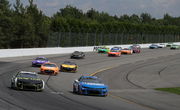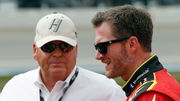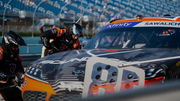
via Getty
HOMESTEAD, FLORIDA – NOVEMBER 17: NASCAR President Steve Phelps speaks to the media prior to the Monster Energy NASCAR Cup Series Ford EcoBoost 400 at Homestead Speedway on November 17, 2019 in Homestead, Florida. (Photo by Brian Lawdermilk/Getty Images)

via Getty
HOMESTEAD, FLORIDA – NOVEMBER 17: NASCAR President Steve Phelps speaks to the media prior to the Monster Energy NASCAR Cup Series Ford EcoBoost 400 at Homestead Speedway on November 17, 2019 in Homestead, Florida. (Photo by Brian Lawdermilk/Getty Images)
What’s the point of winning with a risk that it can be taken away before leaving the track? “I think for us, we’re looking at a total culture change,” said Steve O’Donnell in 2019. Jesse Love Jr. briefly felt like he was on top of the world. The Xfinity Series sensation had just won a race at Rockingham that demonstrated sheer speed, composure, and guts. But before it had a chance to settle, the glory vanished. His first victory was quickly taken away after NASCAR investigators discovered a suspension violation on his No. 2 RCR Chevrolet. The runner-up received the trophy. The audience was in disbelief. The rulebook turned into the narrative once more.
The incident wasn’t the first. Drivers in all three national series have had numerous victories canceled by NASCAR since the sanctioning body implemented automatic post-race disqualifications in 2019. The distinction between justice and overreach has become increasingly hazy with each penalty, from Denny Hamlin’s erased Cup Series victory at Pocono to Ross Chastain’s lost Truck victory. Yet, many are also questioning whether NASCAR has overreached itself in terms of enforcement, given the emergence of the Next Gen vehicle and a rise in technical disqualifications. The entire essence of competition itself is currently being threatened by what was intended to preserve parity.
ADVERTISEMENT
Article continues below this ad
The Next Gen Era: Precision or Peril?
To give the sport’s regulations more legitimacy and clarity, NASCAR first implemented its post-race disqualification procedure in 2019. Before that, midweek penalties were frequently given away, letting drivers keep victories they technically didn’t deserve. Regardless of how dominant the performance was, the governing authority hasn’t reflected hard about removing victories outright since that change.
It’s not that NASCAR didn’t park a driver or a team back in the day. In fact, the first post-race suspension happened back in 1949, when Glenn Dunaway’s car had altered rear springs. Moreover, Emanuel Zervakis also lost his victory at Wilson (N.C) Speedway in 1960 for having a larger fuel cell. But this was the last of it, as the governing body took a more lenient stance against canceling out a driver’s win until the change in 2019.
NASCAR Chief Racing Development Officer and Executive Vice President Steve O’Donnell offered his thoughts on this modification. “We’ve been through a deterrence model where we’ve really worked with the race teams at the track and probably been more lenient than we should in terms of the number of times teams can go through inspection and pass, fail and there’s almost incentive to try to get something by NASCAR, so we want to reverse that trend,” Steve O’Donnell said.
On the other hand, the stakes have only increased—and become more contentious—as the Next Gen age has developed. At Pocono Raceway in 2022, NASCAR dropped a seismic hammer. First to cross the finish line was teammate Kyle Busch, then Denny Hamlin. Joe Gibbs Racing had a dominant day—until it wasn’t. Unauthorized material was discovered on the front fascia of both vehicles by NASCAR inspectors. Chase Elliott, who finished in third position, was proclaimed the winner after both drivers were disqualified in an unusual ruling.

USA Today via Reuters
Jun 26, 2022; Nashville, Tennessee, USA; NASCAR Cup Series driver Kyle Busch (18) during a pit stop during the Ally 400 at Nashville Superspeedway. Mandatory Credit: Christopher Hanewinckel-USA TODAY Sports
This event was the first disqualification of a NASCAR Cup Series race winner following a race since 1960. Heck, this new post-race inspection has also altered championships. Last year, Alex Bowman was disqualified after the playoff race at Charlotte Roval. He finished 18th, and that was enough to see him through to the next round, but his car failed to meet the minimum weight requirement. The ripple effect of this ruling was that Joey Logano bagged those few extra points he needed and went on to stage a championship run.
Fast-forward to April 2025. At Rockingham, Jesse Love Jr., who was already drawing attention in his freshman season, won the North Carolina Education Lottery 250. He was about to celebrate a career milestone after crossing the line first, but NASCAR took it all away. Due to a disqualification caused by an issue in the rear suspension, Sammy Smith was awarded the victory and a $100,000 Dash 4 Cash incentive. Like their predecessors, RCR maintained that there was no performance advantage. Once more, NASCAR remained unflinching. And this was after Parker Kligerman’s win was snatched away at Daytona International Speedway at the start of the season.
“NASCAR rule 14.14.2.i-5.h, which deals with the car’s rear suspension components, was broken, leading to the disqualification. The guideline specifically stipulates that all mating surfaces between the U-bolt saddle and the truck trailing arms must always be in full contact. This was not the case during the post-race inspection, which resulted in the disqualification,” according to NASCAR Xfinity Series Director Eric Peterson.
NASCAR claims that all drivers must follow the same rules, yet that is precisely the issue. Small violations, which are occasionally impossible to detect without laboratory-grade measures, can make the difference between success and failure. The fundamental problem is in how justice is implemented, not in the desire for it. Although NASCAR’s dedication to upholding its regulations is commendable, if every celebration is met with an asterisk and a two-hour delay, the sport runs the risk of offending fans and destroying sentimental moments.
Does NASCAR have the right to rob drivers in broad daylight? According to the rulebook, yes. Yet, the garage and the court of public opinion may be coming to a different conclusion.
Trending
Racing on Eggshells: The Cost of Racing Under the Microscope
In a 2022 interview, Ryan Blaney stated, “I personally like that NASCAR is enforcing things.” The excitement of winning can soon give way to agony in the fast-paced world of NASCAR when the checkered flag is followed by the threat of a post-race penalty. Drivers now experience a special emotional pressure as a result of NASCAR’s increased inspections and disqualifications.
Denny Hamlin’s crew chief for the No. 11 team, Chris Gabehart, slashes through the flawless exterior of NASCAR’s technical accuracy. It’s easy to forget that humans are the ones who drive everything that happens on Sundays, including the strategy, speed, and split-second execution. People who are functioning at an almost surreal level, as Gabehart describes it. “Like in any pro sport, when you turn on the TV or you go to the game and you watch such an amazing thing unfold so seemingly effortlessly, it doesn’t look human. It looks robotic, as does racing at the top level,” Chris Gabehart said, sharing his insight in 2024.
ADVERTISEMENT
Article continues below this ad
Denny Hamlin’s No. 11 Joe Gibbs Racing team received a harsh L2-level punishment in 2024 when they found an engine inspection violation with their Bristol Motor Speedway race-winning engine. The team suffered severe consequences: Hamlin and the team’s owner were each deducted 75 championship points, while Hamlin lost 10 playoff points. Additionally, crew chief Chris Gabehart was fined $100,000. “But it’s done by humans, and humans aren’t perfect, and they make mistakes, and that’s what happened. I’ve made plenty of them that have cost the 11 car a win. Denny’s made plenty of them that have cost the 11 car a win. JGR, Toyota. I mean, we’re teammates,” he added.

USA Today via Reuters
Sep 11, 2022; Kansas City, Kansas, USA; NASCAR Cup Series driver Denny Hamlin (11) takes a pit stop during the Hollywood Casino 400 at Kansas Speedway. Mandatory Credit: Jay Biggerstaff-USA TODAY Sports
In other words, scale is the issue here, not justifications. To the ordinary spectator, a simple mistake like the mishandled spacer that cost Jesse Love Jr. a victory this weekend would seem insignificant. In the garage, though? It’s terrible. Because one part was misaligned, possibly by less than the width of a fingernail, a thousand hours of planning, cooperation, and sacrifice are lost. It’s not about disregarding the rules. It’s about realizing that the discourse needs to change in a post-race society where machines measure human productivity. Not away from responsibility, but in the direction of stability.
ADVERTISEMENT
Article continues below this ad
Drivers’ stakes have definitely increased as a result of the penalties, but fan participation has also been affected. Fans’ emotional attachment to their favorite drivers frequently reflects the feelings that the athletes feel.
ADVERTISEMENT
ADVERTISEMENT
ADVERTISEMENT
ADVERTISEMENT






